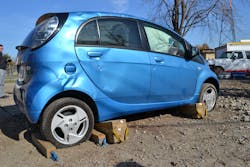University of Extrication: Electric Plug-In Vehicle Stabilization - Part 1
Topic: Electric Plug-In Vehicle (EV) Stabilization, Part 1
Objective: Accomplish effective stabilization, lifting and/or interior extrication tasks on an electric plug-in vehicle
Task: Given an EV with a floorpan-mounted lithium ion battery, the rescue team shall recognize the unusual stabilization, lifting and rescue challenges and be able to effectively adapt their rescue techniques accordingly.
This University of Extrication column launches a three-part series on the seemingly simple task of vehicle stabilization. Rather than focus on one particular vehicle, we will look at a specific category: the electric plug-in vehicle (EV).
EVs, such as the Nissan LEAF, Chevy BOLT EV, BMW i3 and the Tesla Model S, are all different in appearance, have different features and have vastly different price tags. For rescuers, however, they each present specific rescue challenges.
These vehicles all have floorpan-mounted high-voltage (HV) lithium-ion batteries. It is these HV batteries, positioned below the floor of the vehicle, that are the game-changer for responders. If the battery modules and cells are damaged, crushed or punctured in any way, a “thermal runaway event” (a self-igniting fire) can erupt within the battery itself.
These floorpan-mounted HV batteries typically weigh at least several hundred pounds. The HV battery on a Tesla Model S sedan, for example, weighs approximately 1,000 pounds. The entire Chevrolet BOLT EV weighs 3,580 pounds with 960 pounds of that being its floorpan-mounted battery.
Having all that weight below the floor of the EV significantly impacts the vehicle’s center of gravity (aka its balance point). It also creates a large “out of play” area along the underside that responders must avoid contacting when stabilizing or lifting the vehicle.
In this article, we will address rescue techniques that need to be updated or changed when working a crash involving an EV with a floorpan-mounted battery. Later in the series, we will review the techniques rescuers can employ for side-resting and roof-resting stabilization of an EV with a floorpan-mounted HV battery.
Rescue challenges
A Mitsubishi i-MiEV was used for the initial stages of this research project. The i-MiEV is a 4-passenger, 5-door hatchback EV weighing 2,552 pounds. It gets its power from a 606-pound lithium-ion HV floorpan-mounted battery. You can actually see the bottom of the battery compartment when you glance across the undercarriage of the vehicle. This battery location places a significant percentage of weight beneath the floor.
The emergency response guide (ERG) documents provided by each EV manufacturer with floorpan-mounted batteries offer some insight into the three rescue challenges being reviewed in this series: 1) stabilizing 2) lifting and 3) completing interior evolutions.
Stabilization
The ERG for the Nissan LEAF warns responders that they should not stabilize the LEAF with any cribbing placed under the vehicle. The reason being that the floorpan-mounted battery hangs so low to the ground that step chocks or cribbing stacks can actually contact the HV battery compartment. When the tires are deflated during stabilization efforts, incorrectly placed cribbing could crush the cells of the lithium-ion battery as the vehicle settles down.
Lifting
In addition to stabilization warnings, Nissan cautions responders not to place any lifting equipment beneath the LEAF or any of its electronic components. Again, that’s where the floorpan-mounted battery compartment is and where tools cannot be placed when lifting is required. This warning holds true for all EVs with floorpan-mounted batteries.
With the new Tesla Model 3 EV, the floorpan-mounted 400-volt lithium-ion battery occupies almost the entire undercarriage area from the front axle to the rear axle. Tesla also cautions responders that lifting under the floorpan could potentially breach the HV battery. There is this same issue with the Tesla Model S, the Model X and all EVs with floorpan-mounted batteries.
The rescue solution that needs to be adopted is to place cribbing only along the rocker channel during stabilization. This avoids any contact with the HV battery pack. When lifting an EV sitting on its wheels, lifting tools cannot be placed in contact with the floorpan-mounted battery so the rocker channel becomes the prime target for both stabilizing and lifting tool placement.
Interior evolutions
The third rescue task that needs to be addressed is any evolution that could potentially crush or puncture the floor of the vehicle. Dash-jacking or dash-rolling is just one example where a rescue tool might crush or crumple the floor of the vehicle while the work is being accomplished. Any evolution that crushes or punctures the floor can potentially also cause battery contact and lithium-ion cell damage that might result in a spontaneous battery ignition.
Next time
In Part 2, we’ll review techniques for stabilizing a side-resting EV with a floorpan-mounted battery.
SIDEBAR:
Floorpan-Mounted Lithium-Ion Battery Challenges
1) Stabilization
2) Lifting (jacking and shoring)
3) Completing interior evolutions
Read the rest of the series here:
Part 2: Side-resting EVs present unusual stabilization challenges
Part 3: Roof-resting EVs create several challenges
About the Author
Ron Moore
RON MOORE, who is a Firehouse contributing editor, recently retired as a division chief with the McKinney, TX, Fire Department and now serves with Prosper, TX, Fire Rescue. He self-published the Vehicle Rescue 1-2-3 training manual and serves as the forum moderator for the extrication section of Firehouse.com . Moore can be contacted directly at [email protected].

